Holmes Institute HI5004 Marketing Management Report: Unilever Analysis
VerifiedAdded on 2023/03/20
|19
|3764
|28
Report
AI Summary
This report provides a comprehensive marketing analysis of Unilever, a British-Dutch company. It begins with an executive summary and introduction, highlighting Unilever's vision, values, and brand role. The report then delves into a 5C's analysis (Company, Customers, Competition, Collaboration, Context) and a SWOT analysis to examine Unilever's internal and external environments. The report further explores the application of Porter's Five Forces model to assess the competitive landscape. It discusses market segmentation strategies and concludes by developing marketing strategies and tactics for Unilever. The analysis covers various aspects of the company, including its strengths, weaknesses, opportunities, and threats, as well as the preferences and behaviors of its customers. The report references relevant marketing concepts and theories to provide a well-rounded and insightful evaluation of Unilever's marketing management approach.
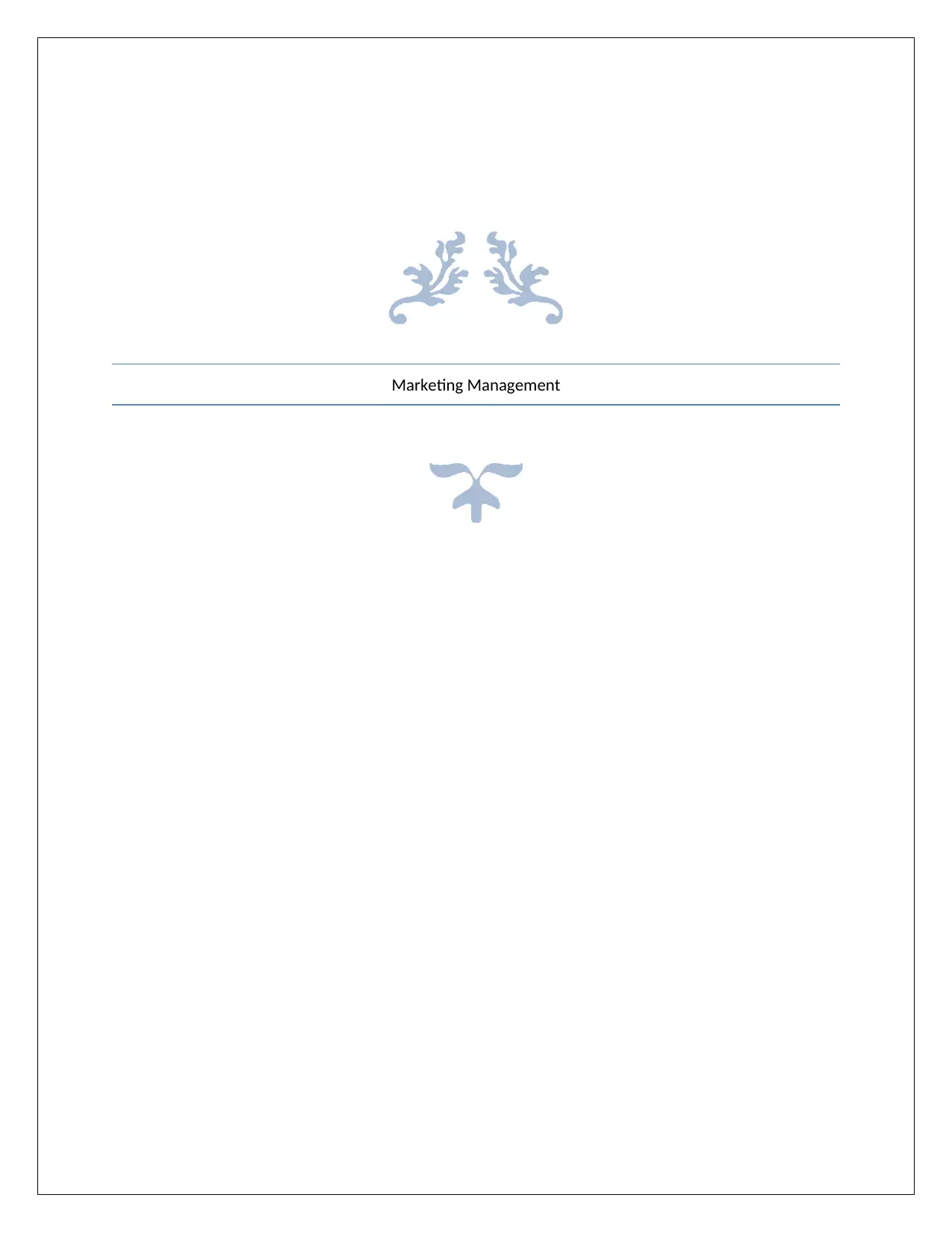
Marketing Management
Paraphrase This Document
Need a fresh take? Get an instant paraphrase of this document with our AI Paraphraser
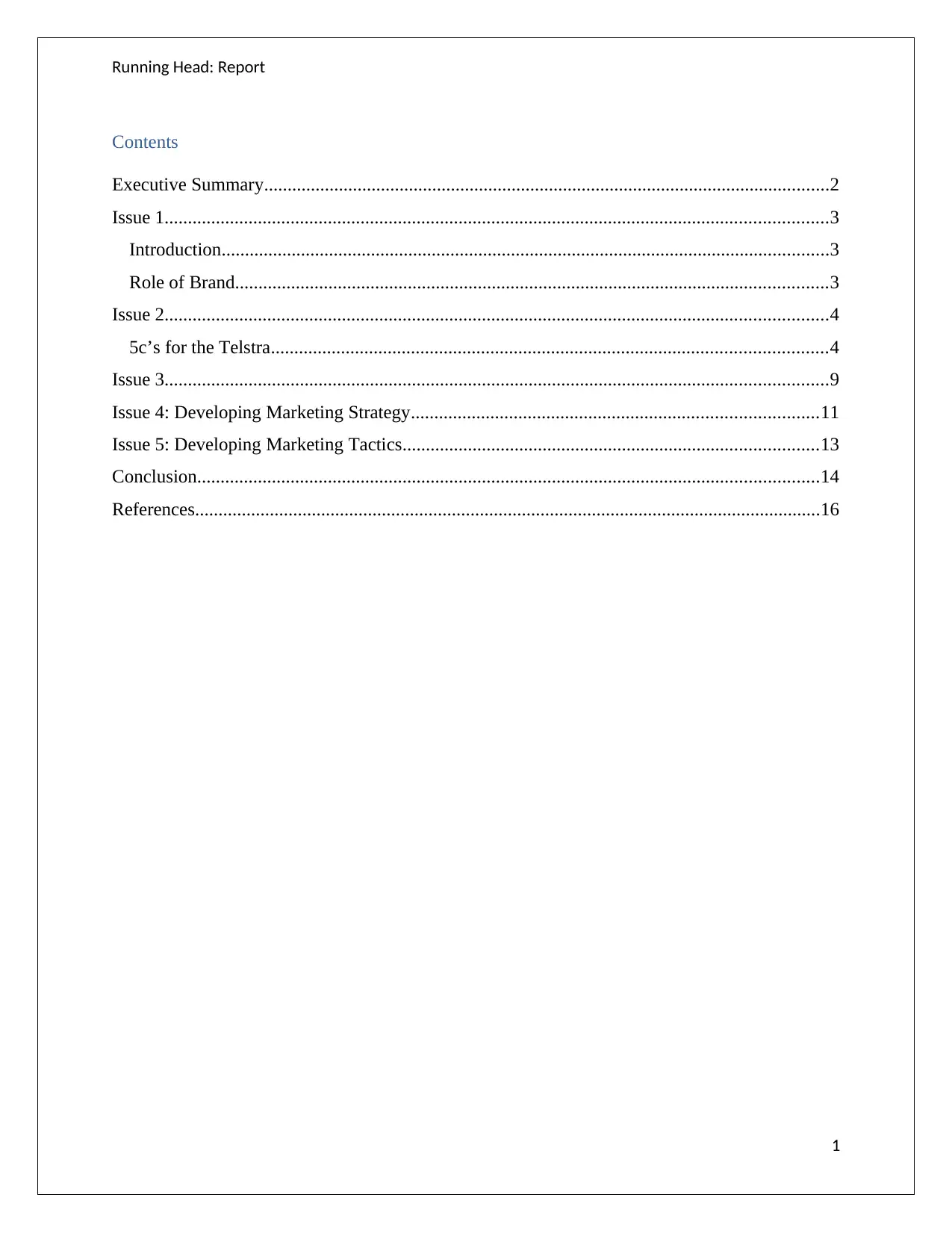
Running Head: Report
Contents
Executive Summary.........................................................................................................................2
Issue 1..............................................................................................................................................3
Introduction..................................................................................................................................3
Role of Brand...............................................................................................................................3
Issue 2..............................................................................................................................................4
5c’s for the Telstra.......................................................................................................................4
Issue 3..............................................................................................................................................9
Issue 4: Developing Marketing Strategy.......................................................................................11
Issue 5: Developing Marketing Tactics.........................................................................................13
Conclusion.....................................................................................................................................14
References......................................................................................................................................16
1
Contents
Executive Summary.........................................................................................................................2
Issue 1..............................................................................................................................................3
Introduction..................................................................................................................................3
Role of Brand...............................................................................................................................3
Issue 2..............................................................................................................................................4
5c’s for the Telstra.......................................................................................................................4
Issue 3..............................................................................................................................................9
Issue 4: Developing Marketing Strategy.......................................................................................11
Issue 5: Developing Marketing Tactics.........................................................................................13
Conclusion.....................................................................................................................................14
References......................................................................................................................................16
1
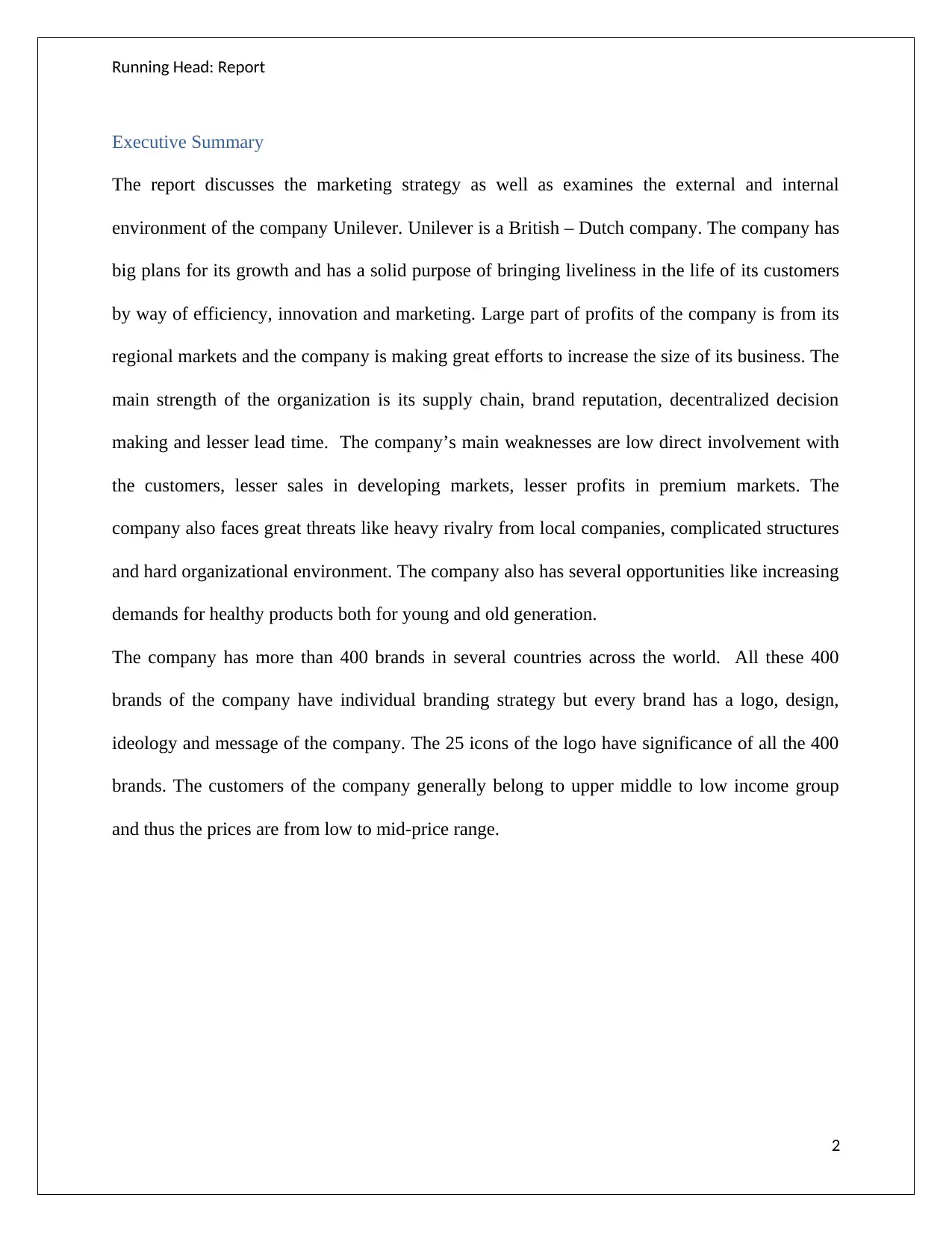
Running Head: Report
Executive Summary
The report discusses the marketing strategy as well as examines the external and internal
environment of the company Unilever. Unilever is a British – Dutch company. The company has
big plans for its growth and has a solid purpose of bringing liveliness in the life of its customers
by way of efficiency, innovation and marketing. Large part of profits of the company is from its
regional markets and the company is making great efforts to increase the size of its business. The
main strength of the organization is its supply chain, brand reputation, decentralized decision
making and lesser lead time. The company’s main weaknesses are low direct involvement with
the customers, lesser sales in developing markets, lesser profits in premium markets. The
company also faces great threats like heavy rivalry from local companies, complicated structures
and hard organizational environment. The company also has several opportunities like increasing
demands for healthy products both for young and old generation.
The company has more than 400 brands in several countries across the world. All these 400
brands of the company have individual branding strategy but every brand has a logo, design,
ideology and message of the company. The 25 icons of the logo have significance of all the 400
brands. The customers of the company generally belong to upper middle to low income group
and thus the prices are from low to mid-price range.
2
Executive Summary
The report discusses the marketing strategy as well as examines the external and internal
environment of the company Unilever. Unilever is a British – Dutch company. The company has
big plans for its growth and has a solid purpose of bringing liveliness in the life of its customers
by way of efficiency, innovation and marketing. Large part of profits of the company is from its
regional markets and the company is making great efforts to increase the size of its business. The
main strength of the organization is its supply chain, brand reputation, decentralized decision
making and lesser lead time. The company’s main weaknesses are low direct involvement with
the customers, lesser sales in developing markets, lesser profits in premium markets. The
company also faces great threats like heavy rivalry from local companies, complicated structures
and hard organizational environment. The company also has several opportunities like increasing
demands for healthy products both for young and old generation.
The company has more than 400 brands in several countries across the world. All these 400
brands of the company have individual branding strategy but every brand has a logo, design,
ideology and message of the company. The 25 icons of the logo have significance of all the 400
brands. The customers of the company generally belong to upper middle to low income group
and thus the prices are from low to mid-price range.
2
⊘ This is a preview!⊘
Do you want full access?
Subscribe today to unlock all pages.

Trusted by 1+ million students worldwide
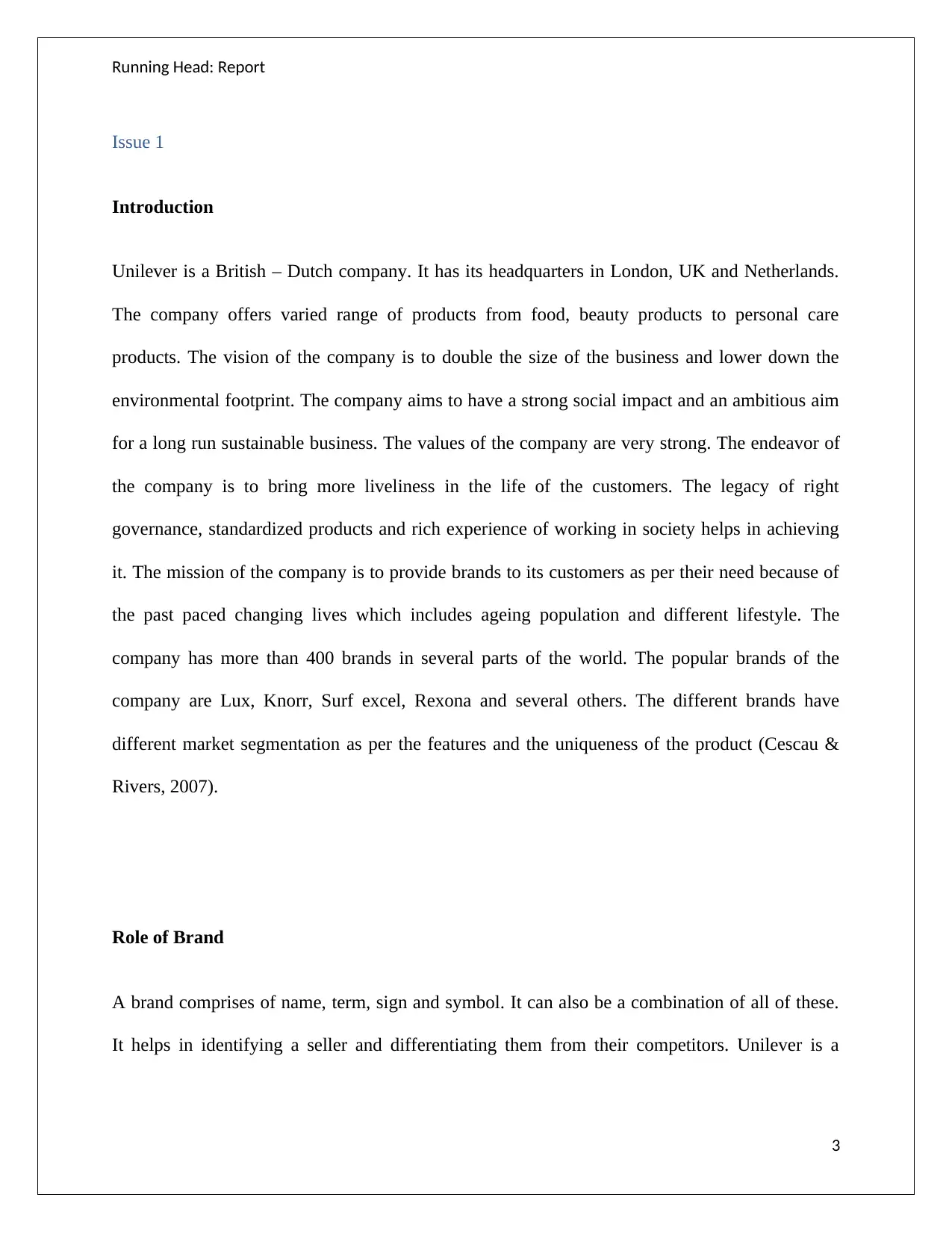
Running Head: Report
Issue 1
Introduction
Unilever is a British – Dutch company. It has its headquarters in London, UK and Netherlands.
The company offers varied range of products from food, beauty products to personal care
products. The vision of the company is to double the size of the business and lower down the
environmental footprint. The company aims to have a strong social impact and an ambitious aim
for a long run sustainable business. The values of the company are very strong. The endeavor of
the company is to bring more liveliness in the life of the customers. The legacy of right
governance, standardized products and rich experience of working in society helps in achieving
it. The mission of the company is to provide brands to its customers as per their need because of
the past paced changing lives which includes ageing population and different lifestyle. The
company has more than 400 brands in several parts of the world. The popular brands of the
company are Lux, Knorr, Surf excel, Rexona and several others. The different brands have
different market segmentation as per the features and the uniqueness of the product (Cescau &
Rivers, 2007).
Role of Brand
A brand comprises of name, term, sign and symbol. It can also be a combination of all of these.
It helps in identifying a seller and differentiating them from their competitors. Unilever is a
3
Issue 1
Introduction
Unilever is a British – Dutch company. It has its headquarters in London, UK and Netherlands.
The company offers varied range of products from food, beauty products to personal care
products. The vision of the company is to double the size of the business and lower down the
environmental footprint. The company aims to have a strong social impact and an ambitious aim
for a long run sustainable business. The values of the company are very strong. The endeavor of
the company is to bring more liveliness in the life of the customers. The legacy of right
governance, standardized products and rich experience of working in society helps in achieving
it. The mission of the company is to provide brands to its customers as per their need because of
the past paced changing lives which includes ageing population and different lifestyle. The
company has more than 400 brands in several parts of the world. The popular brands of the
company are Lux, Knorr, Surf excel, Rexona and several others. The different brands have
different market segmentation as per the features and the uniqueness of the product (Cescau &
Rivers, 2007).
Role of Brand
A brand comprises of name, term, sign and symbol. It can also be a combination of all of these.
It helps in identifying a seller and differentiating them from their competitors. Unilever is a
3
Paraphrase This Document
Need a fresh take? Get an instant paraphrase of this document with our AI Paraphraser
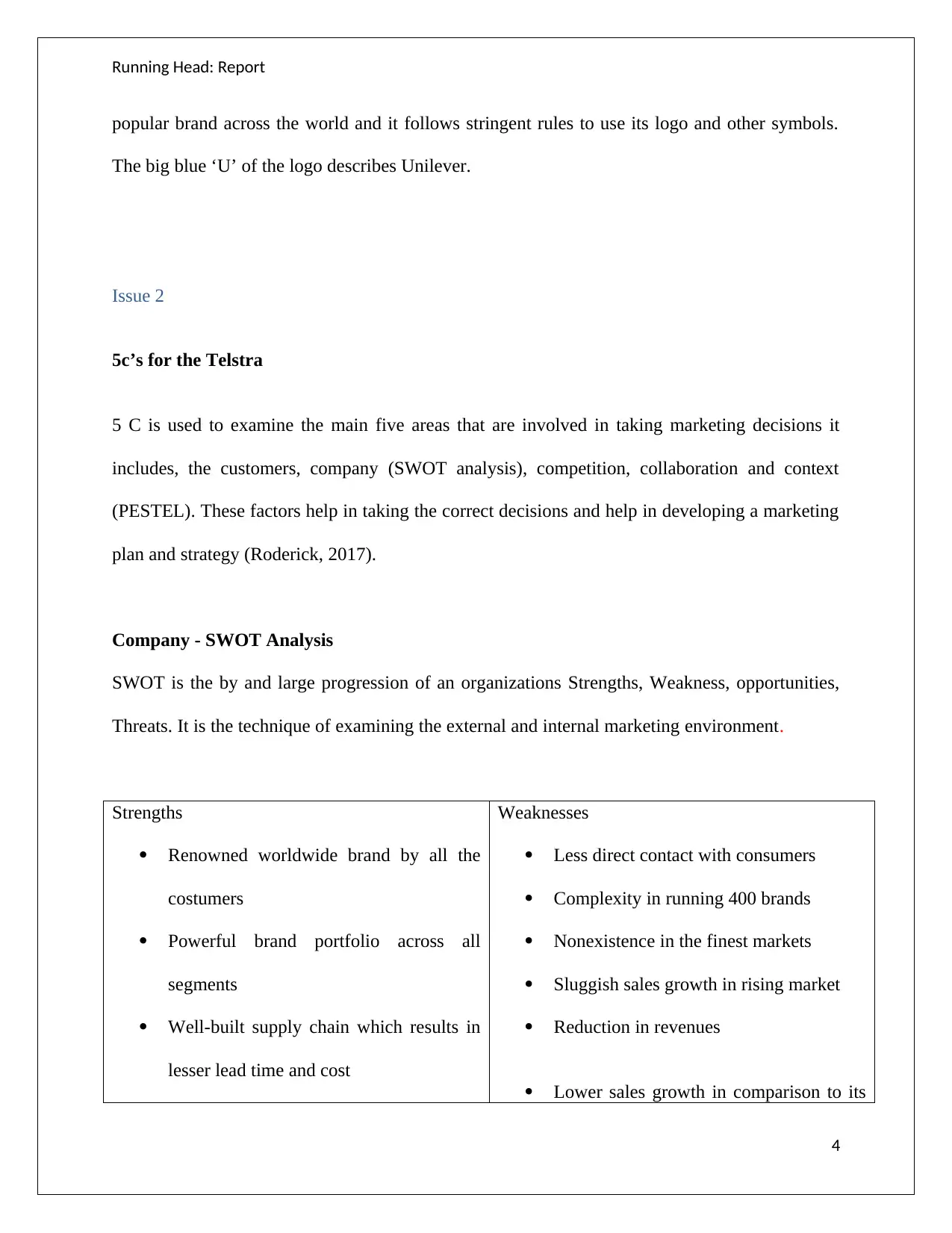
Running Head: Report
popular brand across the world and it follows stringent rules to use its logo and other symbols.
The big blue ‘U’ of the logo describes Unilever.
Issue 2
5c’s for the Telstra
5 C is used to examine the main five areas that are involved in taking marketing decisions it
includes, the customers, company (SWOT analysis), competition, collaboration and context
(PESTEL). These factors help in taking the correct decisions and help in developing a marketing
plan and strategy (Roderick, 2017).
Company - SWOT Analysis
SWOT is the by and large progression of an organizations Strengths, Weakness, opportunities,
Threats. It is the technique of examining the external and internal marketing environment.
Strengths
Renowned worldwide brand by all the
costumers
Powerful brand portfolio across all
segments
Well-built supply chain which results in
lesser lead time and cost
Weaknesses
Less direct contact with consumers
Complexity in running 400 brands
Nonexistence in the finest markets
Sluggish sales growth in rising market
Reduction in revenues
Lower sales growth in comparison to its
4
popular brand across the world and it follows stringent rules to use its logo and other symbols.
The big blue ‘U’ of the logo describes Unilever.
Issue 2
5c’s for the Telstra
5 C is used to examine the main five areas that are involved in taking marketing decisions it
includes, the customers, company (SWOT analysis), competition, collaboration and context
(PESTEL). These factors help in taking the correct decisions and help in developing a marketing
plan and strategy (Roderick, 2017).
Company - SWOT Analysis
SWOT is the by and large progression of an organizations Strengths, Weakness, opportunities,
Threats. It is the technique of examining the external and internal marketing environment.
Strengths
Renowned worldwide brand by all the
costumers
Powerful brand portfolio across all
segments
Well-built supply chain which results in
lesser lead time and cost
Weaknesses
Less direct contact with consumers
Complexity in running 400 brands
Nonexistence in the finest markets
Sluggish sales growth in rising market
Reduction in revenues
Lower sales growth in comparison to its
4
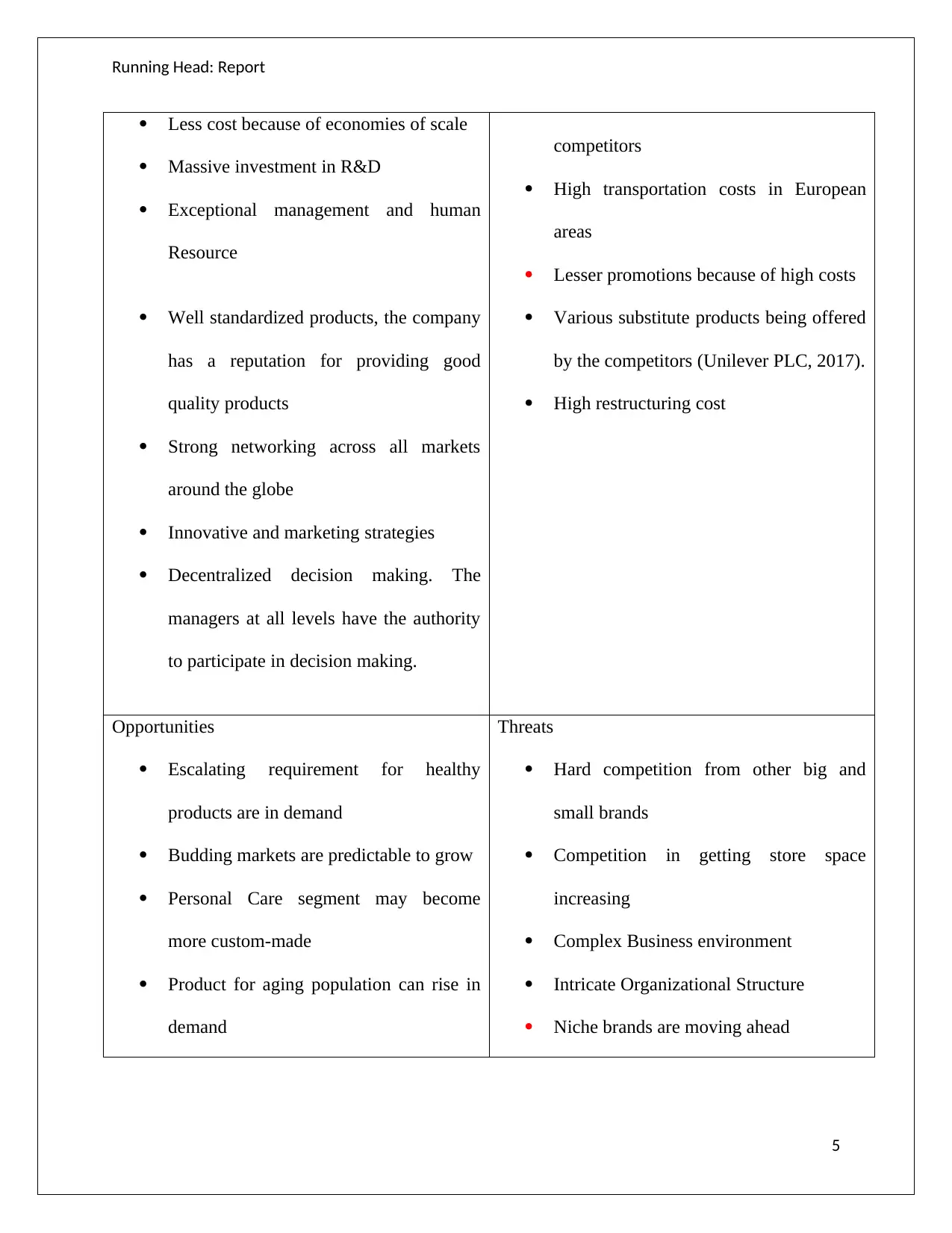
Running Head: Report
Less cost because of economies of scale
Massive investment in R&D
Exceptional management and human
Resource
Well standardized products, the company
has a reputation for providing good
quality products
Strong networking across all markets
around the globe
Innovative and marketing strategies
Decentralized decision making. The
managers at all levels have the authority
to participate in decision making.
competitors
High transportation costs in European
areas
Lesser promotions because of high costs
Various substitute products being offered
by the competitors (Unilever PLC, 2017).
High restructuring cost
Opportunities
Escalating requirement for healthy
products are in demand
Budding markets are predictable to grow
Personal Care segment may become
more custom-made
Product for aging population can rise in
demand
Threats
Hard competition from other big and
small brands
Competition in getting store space
increasing
Complex Business environment
Intricate Organizational Structure
Niche brands are moving ahead
5
Less cost because of economies of scale
Massive investment in R&D
Exceptional management and human
Resource
Well standardized products, the company
has a reputation for providing good
quality products
Strong networking across all markets
around the globe
Innovative and marketing strategies
Decentralized decision making. The
managers at all levels have the authority
to participate in decision making.
competitors
High transportation costs in European
areas
Lesser promotions because of high costs
Various substitute products being offered
by the competitors (Unilever PLC, 2017).
High restructuring cost
Opportunities
Escalating requirement for healthy
products are in demand
Budding markets are predictable to grow
Personal Care segment may become
more custom-made
Product for aging population can rise in
demand
Threats
Hard competition from other big and
small brands
Competition in getting store space
increasing
Complex Business environment
Intricate Organizational Structure
Niche brands are moving ahead
5
⊘ This is a preview!⊘
Do you want full access?
Subscribe today to unlock all pages.

Trusted by 1+ million students worldwide
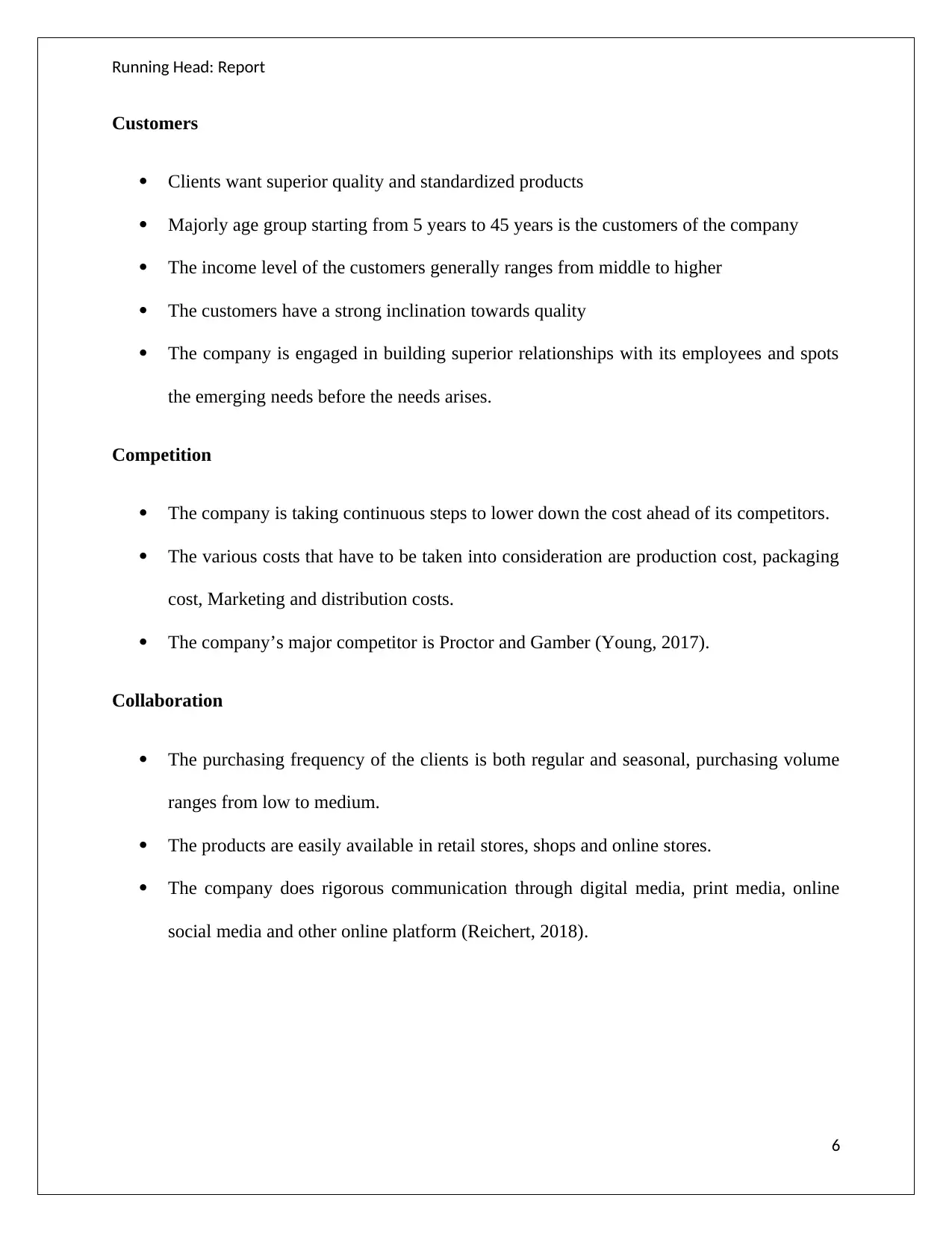
Running Head: Report
Customers
Clients want superior quality and standardized products
Majorly age group starting from 5 years to 45 years is the customers of the company
The income level of the customers generally ranges from middle to higher
The customers have a strong inclination towards quality
The company is engaged in building superior relationships with its employees and spots
the emerging needs before the needs arises.
Competition
The company is taking continuous steps to lower down the cost ahead of its competitors.
The various costs that have to be taken into consideration are production cost, packaging
cost, Marketing and distribution costs.
The company’s major competitor is Proctor and Gamber (Young, 2017).
Collaboration
The purchasing frequency of the clients is both regular and seasonal, purchasing volume
ranges from low to medium.
The products are easily available in retail stores, shops and online stores.
The company does rigorous communication through digital media, print media, online
social media and other online platform (Reichert, 2018).
6
Customers
Clients want superior quality and standardized products
Majorly age group starting from 5 years to 45 years is the customers of the company
The income level of the customers generally ranges from middle to higher
The customers have a strong inclination towards quality
The company is engaged in building superior relationships with its employees and spots
the emerging needs before the needs arises.
Competition
The company is taking continuous steps to lower down the cost ahead of its competitors.
The various costs that have to be taken into consideration are production cost, packaging
cost, Marketing and distribution costs.
The company’s major competitor is Proctor and Gamber (Young, 2017).
Collaboration
The purchasing frequency of the clients is both regular and seasonal, purchasing volume
ranges from low to medium.
The products are easily available in retail stores, shops and online stores.
The company does rigorous communication through digital media, print media, online
social media and other online platform (Reichert, 2018).
6
Paraphrase This Document
Need a fresh take? Get an instant paraphrase of this document with our AI Paraphraser
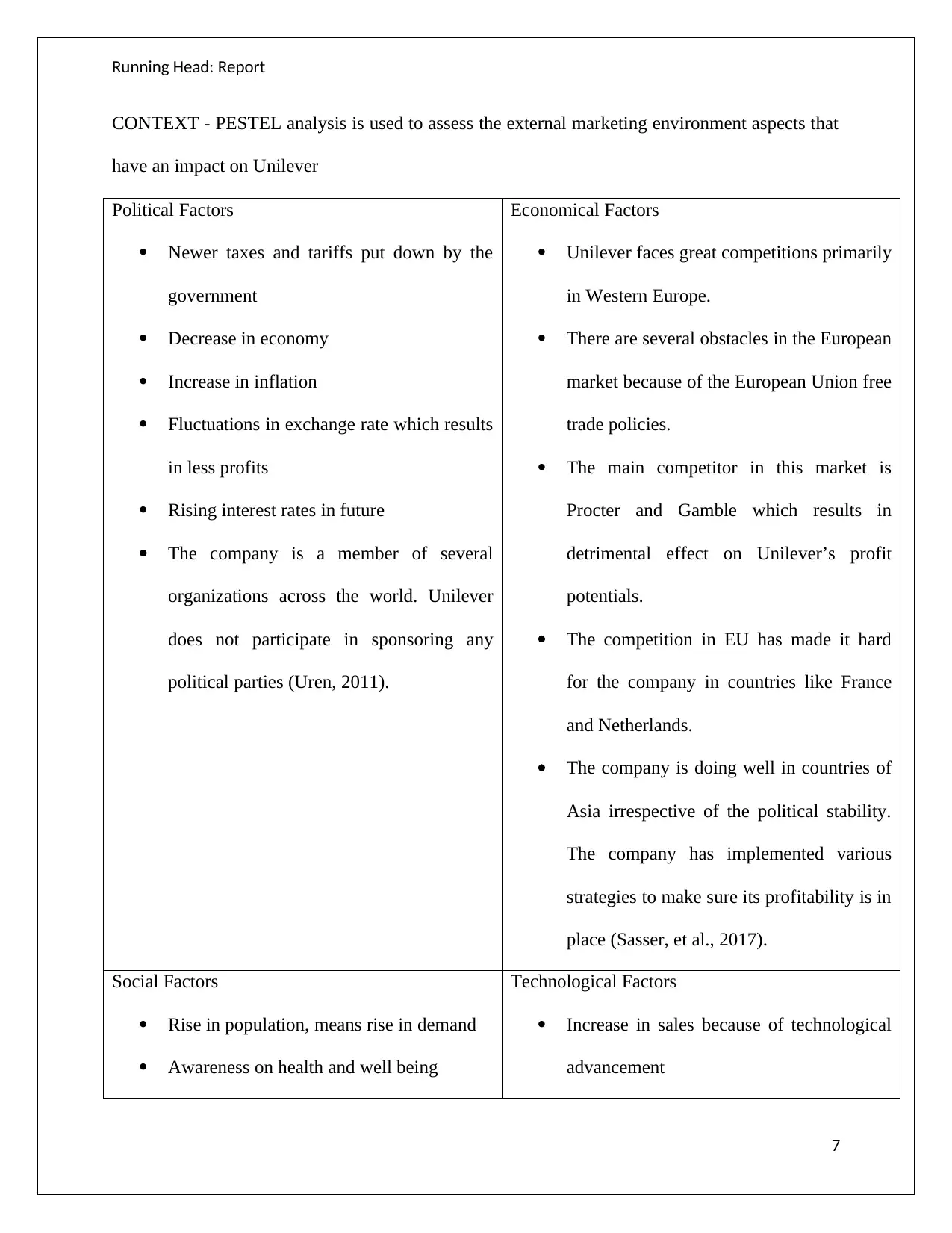
Running Head: Report
CONTEXT - PESTEL analysis is used to assess the external marketing environment aspects that
have an impact on Unilever
Political Factors
Newer taxes and tariffs put down by the
government
Decrease in economy
Increase in inflation
Fluctuations in exchange rate which results
in less profits
Rising interest rates in future
The company is a member of several
organizations across the world. Unilever
does not participate in sponsoring any
political parties (Uren, 2011).
Economical Factors
Unilever faces great competitions primarily
in Western Europe.
There are several obstacles in the European
market because of the European Union free
trade policies.
The main competitor in this market is
Procter and Gamble which results in
detrimental effect on Unilever’s profit
potentials.
The competition in EU has made it hard
for the company in countries like France
and Netherlands.
The company is doing well in countries of
Asia irrespective of the political stability.
The company has implemented various
strategies to make sure its profitability is in
place (Sasser, et al., 2017).
Social Factors
Rise in population, means rise in demand
Awareness on health and well being
Technological Factors
Increase in sales because of technological
advancement
7
CONTEXT - PESTEL analysis is used to assess the external marketing environment aspects that
have an impact on Unilever
Political Factors
Newer taxes and tariffs put down by the
government
Decrease in economy
Increase in inflation
Fluctuations in exchange rate which results
in less profits
Rising interest rates in future
The company is a member of several
organizations across the world. Unilever
does not participate in sponsoring any
political parties (Uren, 2011).
Economical Factors
Unilever faces great competitions primarily
in Western Europe.
There are several obstacles in the European
market because of the European Union free
trade policies.
The main competitor in this market is
Procter and Gamble which results in
detrimental effect on Unilever’s profit
potentials.
The competition in EU has made it hard
for the company in countries like France
and Netherlands.
The company is doing well in countries of
Asia irrespective of the political stability.
The company has implemented various
strategies to make sure its profitability is in
place (Sasser, et al., 2017).
Social Factors
Rise in population, means rise in demand
Awareness on health and well being
Technological Factors
Increase in sales because of technological
advancement
7

Running Head: Report
Uneducated masses of rising markets, that
has an impact on the marketing campaigns
Changes in awareness of nutrition
Unilever is doing well in continuing its
cultural environment by providing better
nutrition and hygiene factors primarily in
Africa and Asia.
The company has initiated a program
“Dove self-esteem “to boost the confidence
of girls, by reaching out to 5 million young
people.
The company employees more than 100
nationalities to make sure that there is
diversified working environment.
Rapid change in technology makes existing
technology outdated
More funds are required for upgrading to
new technology
Improved cost efficiency
The company has been working to increase
its presence on web to progress in their
brand communication.
The company is also working towards
lowering down cost by using more
technological tools at global level.
The company is also associated with
Unilever R&D to fulfill the requirements
of the customers (Unilever, 2014).
Environmental Factors
The rapid changes in environment can have
converse effect on tea production
The rising polluted water can result in rise
in demand of Pureit (Australian Financial,
2019).
Legal Factors
Complex business rules and regulations
8
Uneducated masses of rising markets, that
has an impact on the marketing campaigns
Changes in awareness of nutrition
Unilever is doing well in continuing its
cultural environment by providing better
nutrition and hygiene factors primarily in
Africa and Asia.
The company has initiated a program
“Dove self-esteem “to boost the confidence
of girls, by reaching out to 5 million young
people.
The company employees more than 100
nationalities to make sure that there is
diversified working environment.
Rapid change in technology makes existing
technology outdated
More funds are required for upgrading to
new technology
Improved cost efficiency
The company has been working to increase
its presence on web to progress in their
brand communication.
The company is also working towards
lowering down cost by using more
technological tools at global level.
The company is also associated with
Unilever R&D to fulfill the requirements
of the customers (Unilever, 2014).
Environmental Factors
The rapid changes in environment can have
converse effect on tea production
The rising polluted water can result in rise
in demand of Pureit (Australian Financial,
2019).
Legal Factors
Complex business rules and regulations
8
⊘ This is a preview!⊘
Do you want full access?
Subscribe today to unlock all pages.

Trusted by 1+ million students worldwide
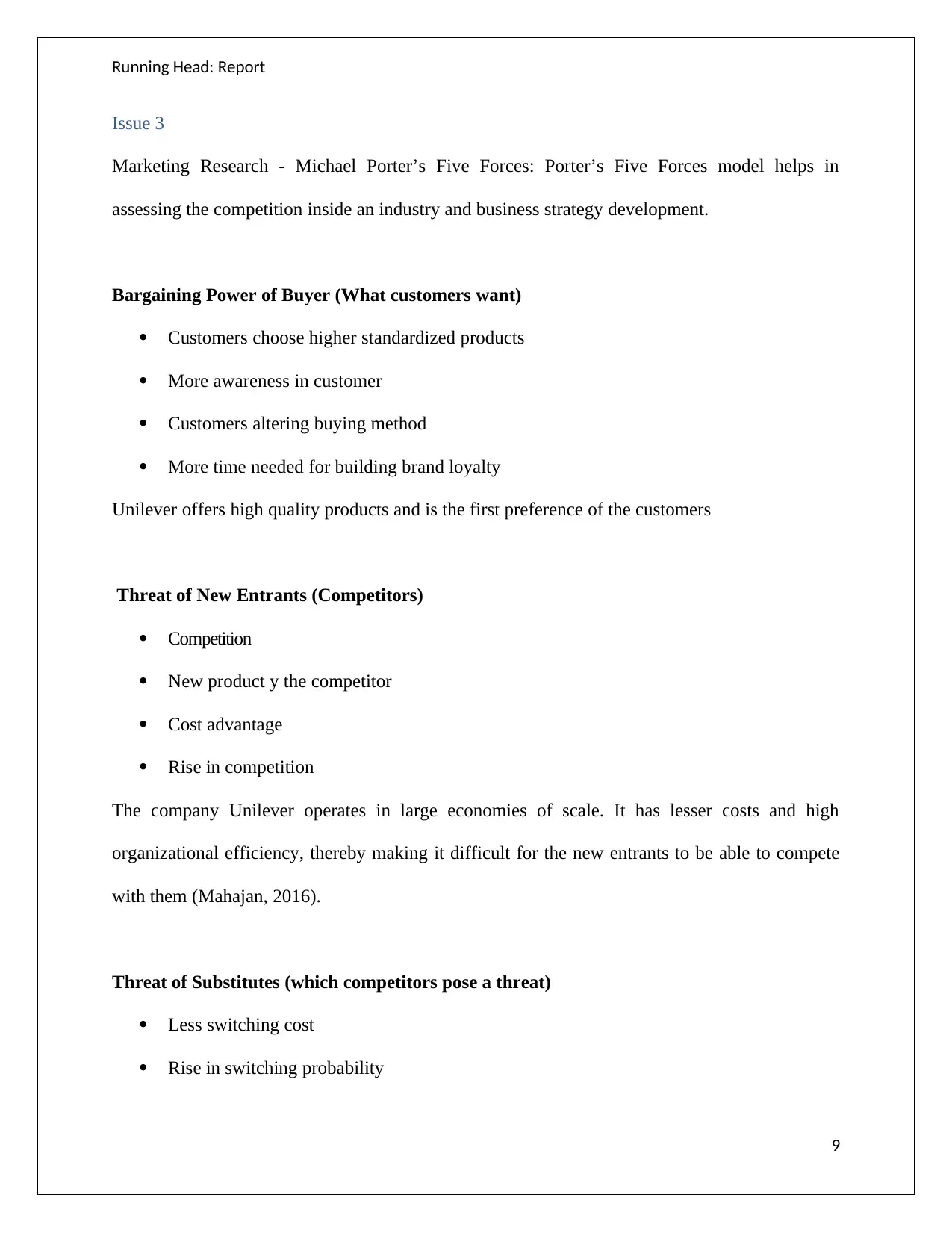
Running Head: Report
Issue 3
Marketing Research - Michael Porter’s Five Forces: Porter’s Five Forces model helps in
assessing the competition inside an industry and business strategy development.
Bargaining Power of Buyer (What customers want)
Customers choose higher standardized products
More awareness in customer
Customers altering buying method
More time needed for building brand loyalty
Unilever offers high quality products and is the first preference of the customers
Threat of New Entrants (Competitors)
Competition
New product y the competitor
Cost advantage
Rise in competition
The company Unilever operates in large economies of scale. It has lesser costs and high
organizational efficiency, thereby making it difficult for the new entrants to be able to compete
with them (Mahajan, 2016).
Threat of Substitutes (which competitors pose a threat)
Less switching cost
Rise in switching probability
9
Issue 3
Marketing Research - Michael Porter’s Five Forces: Porter’s Five Forces model helps in
assessing the competition inside an industry and business strategy development.
Bargaining Power of Buyer (What customers want)
Customers choose higher standardized products
More awareness in customer
Customers altering buying method
More time needed for building brand loyalty
Unilever offers high quality products and is the first preference of the customers
Threat of New Entrants (Competitors)
Competition
New product y the competitor
Cost advantage
Rise in competition
The company Unilever operates in large economies of scale. It has lesser costs and high
organizational efficiency, thereby making it difficult for the new entrants to be able to compete
with them (Mahajan, 2016).
Threat of Substitutes (which competitors pose a threat)
Less switching cost
Rise in switching probability
9
Paraphrase This Document
Need a fresh take? Get an instant paraphrase of this document with our AI Paraphraser
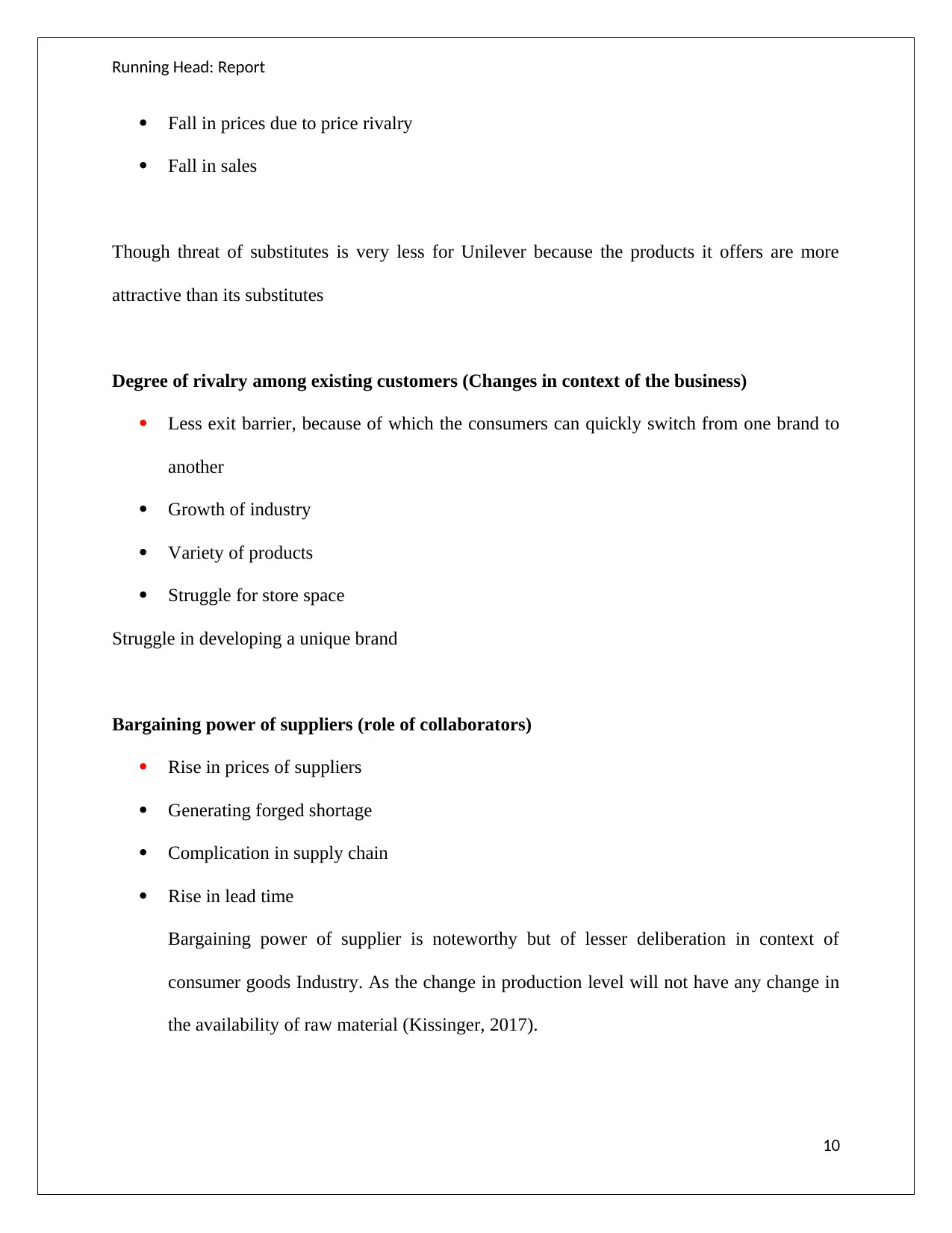
Running Head: Report
Fall in prices due to price rivalry
Fall in sales
Though threat of substitutes is very less for Unilever because the products it offers are more
attractive than its substitutes
Degree of rivalry among existing customers (Changes in context of the business)
Less exit barrier, because of which the consumers can quickly switch from one brand to
another
Growth of industry
Variety of products
Struggle for store space
Struggle in developing a unique brand
Bargaining power of suppliers (role of collaborators)
Rise in prices of suppliers
Generating forged shortage
Complication in supply chain
Rise in lead time
Bargaining power of supplier is noteworthy but of lesser deliberation in context of
consumer goods Industry. As the change in production level will not have any change in
the availability of raw material (Kissinger, 2017).
10
Fall in prices due to price rivalry
Fall in sales
Though threat of substitutes is very less for Unilever because the products it offers are more
attractive than its substitutes
Degree of rivalry among existing customers (Changes in context of the business)
Less exit barrier, because of which the consumers can quickly switch from one brand to
another
Growth of industry
Variety of products
Struggle for store space
Struggle in developing a unique brand
Bargaining power of suppliers (role of collaborators)
Rise in prices of suppliers
Generating forged shortage
Complication in supply chain
Rise in lead time
Bargaining power of supplier is noteworthy but of lesser deliberation in context of
consumer goods Industry. As the change in production level will not have any change in
the availability of raw material (Kissinger, 2017).
10
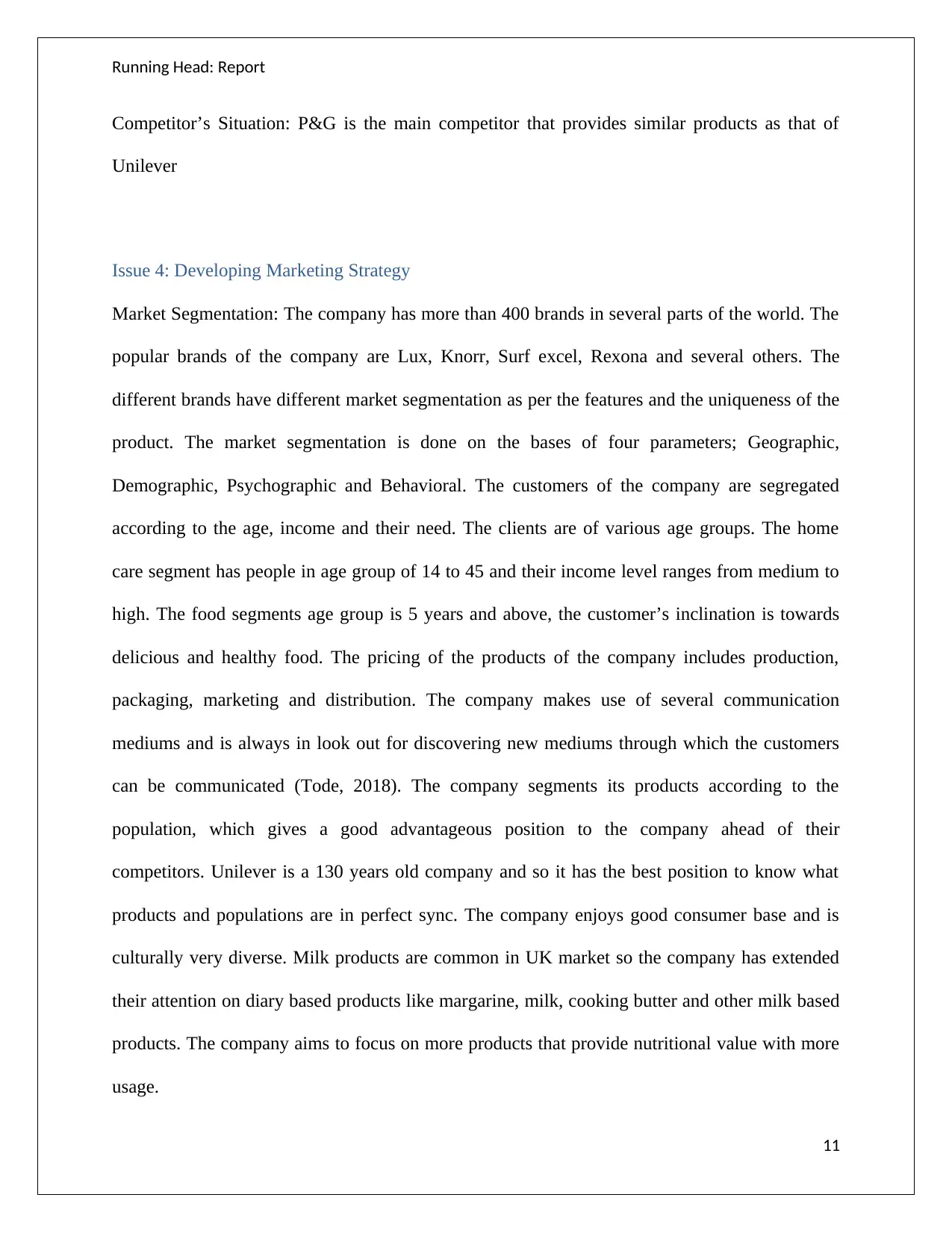
Running Head: Report
Competitor’s Situation: P&G is the main competitor that provides similar products as that of
Unilever
Issue 4: Developing Marketing Strategy
Market Segmentation: The company has more than 400 brands in several parts of the world. The
popular brands of the company are Lux, Knorr, Surf excel, Rexona and several others. The
different brands have different market segmentation as per the features and the uniqueness of the
product. The market segmentation is done on the bases of four parameters; Geographic,
Demographic, Psychographic and Behavioral. The customers of the company are segregated
according to the age, income and their need. The clients are of various age groups. The home
care segment has people in age group of 14 to 45 and their income level ranges from medium to
high. The food segments age group is 5 years and above, the customer’s inclination is towards
delicious and healthy food. The pricing of the products of the company includes production,
packaging, marketing and distribution. The company makes use of several communication
mediums and is always in look out for discovering new mediums through which the customers
can be communicated (Tode, 2018). The company segments its products according to the
population, which gives a good advantageous position to the company ahead of their
competitors. Unilever is a 130 years old company and so it has the best position to know what
products and populations are in perfect sync. The company enjoys good consumer base and is
culturally very diverse. Milk products are common in UK market so the company has extended
their attention on diary based products like margarine, milk, cooking butter and other milk based
products. The company aims to focus on more products that provide nutritional value with more
usage.
11
Competitor’s Situation: P&G is the main competitor that provides similar products as that of
Unilever
Issue 4: Developing Marketing Strategy
Market Segmentation: The company has more than 400 brands in several parts of the world. The
popular brands of the company are Lux, Knorr, Surf excel, Rexona and several others. The
different brands have different market segmentation as per the features and the uniqueness of the
product. The market segmentation is done on the bases of four parameters; Geographic,
Demographic, Psychographic and Behavioral. The customers of the company are segregated
according to the age, income and their need. The clients are of various age groups. The home
care segment has people in age group of 14 to 45 and their income level ranges from medium to
high. The food segments age group is 5 years and above, the customer’s inclination is towards
delicious and healthy food. The pricing of the products of the company includes production,
packaging, marketing and distribution. The company makes use of several communication
mediums and is always in look out for discovering new mediums through which the customers
can be communicated (Tode, 2018). The company segments its products according to the
population, which gives a good advantageous position to the company ahead of their
competitors. Unilever is a 130 years old company and so it has the best position to know what
products and populations are in perfect sync. The company enjoys good consumer base and is
culturally very diverse. Milk products are common in UK market so the company has extended
their attention on diary based products like margarine, milk, cooking butter and other milk based
products. The company aims to focus on more products that provide nutritional value with more
usage.
11
⊘ This is a preview!⊘
Do you want full access?
Subscribe today to unlock all pages.

Trusted by 1+ million students worldwide
1 out of 19
Related Documents
Your All-in-One AI-Powered Toolkit for Academic Success.
+13062052269
info@desklib.com
Available 24*7 on WhatsApp / Email
![[object Object]](/_next/static/media/star-bottom.7253800d.svg)
Unlock your academic potential
Copyright © 2020–2025 A2Z Services. All Rights Reserved. Developed and managed by ZUCOL.




